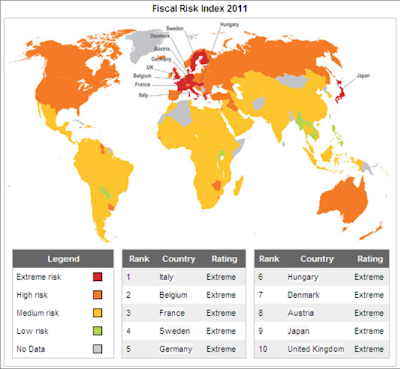Risk analysis firm Maplecroft just released its new fiscal risk index ranking of 163 countries. Europe trumps all other regions with 11 out of twelve courtiers rated as "extreme risk." However, quite surprisingly, only one PIIGS country--Italy which takes the top spot--is in the top 12.
 Source: Maplecroft
Source: Maplecroft
Low Senior Labor Participation Rate
U.S. in Wave 2
 Source: Maplecroft
Source: MaplecroftLow Senior Labor Participation Rate
Another problem within Europe is that it has a low labor participation rate in the 65+ age bracket. In fact, the labor market participation of age 65+ amongst the ‘extreme risk’ nations ranges from 1.4% in France, 7.71% in UK, to 11.7% in Sweden, vs. a 28% average across all countries ranked in the index.
U.S. – High Fiscal Risk
Although the United States is not ranked among the "extreme fiscal risk," the country is nevertheless classified as "high risk", along with Spain, also a member in PIIGS, Australia, Canada, and Russia.
Let's take a look at the two metrics mentioned here.
The dependency ration in the U.S. is 22 in 2010, but is projected to climb rapidly to 35 in 2030, according to the U.S. Census Bureau, mainly due to baby boomers moving up into the 65+ age bracket.
The ratio then will rise more slowly to 37 in 2050.
The labor participation for age 65 and over in the U.S. is at 17.5 according to data at Bureau of Labor Statistics (BLS). This is better than most of the European countries, but below the overall average of 28%.
U.S. in Wave 2
Most people typically associate country’s fiscal risk to the government’s monetary and fiscal policies and Lehman Brothers has taught us that banking and housing crisis could push the entire world into the Great Recession. While these are definite risk factors, a highly productive labor force and relatively young population makeup tend to mean sustainable prosperity and better odds at climbing out of a hole.
The Maplecroft study concludes
"...in high risk countries, it is increasingly likely that the private sector will be called upon to contribute in the form of pensions and private health care.... Without significant adjustments, such as raising taxes or reducing spending, countries risk going bankrupt."
"...in high risk countries, it is increasingly likely that the private sector will be called upon to contribute in the form of pensions and private health care.... Without significant adjustments, such as raising taxes or reducing spending, countries risk going bankrupt."
So, while widespread protests are still going on in Europe over pension age being raised and many austerity measures, amid the European sovereign debt crisis, the U.S. and other countries in the same “high fiscal risk” could be the wave 2 of this global fiscal chain of events.